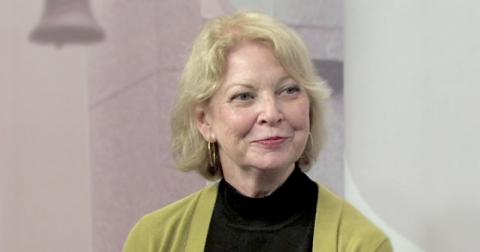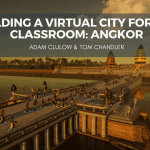From the editor: In 1985, when I was finishing my dissertation and starting to teach in Stanford’s innovative alternative to the standard Western Civ course, everyone was talking about creating de-centered classrooms. Faculty from History, English, Classics, and Sociology all wanted to reduce the intimidating authority of the Lecturing Professor. But no one knew how. Or perhaps no one was all that willing to give up the safety of standing on stage telling good stories and imparting wisdom. But now, all these years later, new tools, many of them digital, are encouraging professors to rethink the ways we interact with students in our classrooms in order to develop more effective ways of teaching. At UT Austin, Penne Restad and Karl Hagstrom Miller are leading these exciting efforts.
By Joan Neuberger
“Who knows?” Karl Hagstrom Miller shrugs his shoulders for emphasis. “I’ve been asking that question a lot lately, and now I am encouraging my students to do the same. I’m beginning to think it might be the best question an historian could ever ask.”
This fall, Dr. Miller and his History Department colleague Dr. Penne Restad are launching an ambitious project to invent better ways to teach history in the undergraduate classroom. The project is funded by the UT Course Transformation Program. The CTP is dedicated to increasing student learning in large enrollment, lower division courses. Restad and Miller are re-designing the US history survey sequence, courses with the largest enrollments in the department. But the scope of the project reaches well beyond the survey. It is already fostering conversations among faculty, graduate students, and undergrads about history, learning, and the changing landscape of higher education.

“There is a revolution going on in higher ed unlike anything we have seen in over a century,” says Restad. “But be careful what you call it. Many of the terms people use sound like they are picking a fight.” Disruptive innovation, digital humanities, flipped classrooms, educational cost disease, quantitative assessment, massive open online courses (MOOCs). For the past several years Restad and Miller have been surveying the literature on learning, digital technology, historical methodology, and the economic challenges of higher education. It is a vast body of work, but they are finding connections and parallels that emerge as they try to get these literatures to talk with each other. “We aren’t interested in jumping behind one single approach that is already out there,” Restad notes. “We want to know about them all so they can help us improve what we already do well: help undergraduates learn history.”
“That’s why I like saying ‘who knows?’” Miller adds. “The phrase is an admission of ignorance. Many undergraduates don’t see their professors as ignorant about aspects of the past, and standard history textbooks don’t cop to their ignorance either. But recognizing what we don’t know—even what we can’t know—about the past is the first step to becoming a good historian. A great deal of history is simply unknowable, inaccessible. The best we can do is carefully construct stories about the past out of the incomplete and fragmentary historical evidence that we have while continuing to look for more. We want to open up undergraduates to the mystery of the historical past.”

“That means starting students off by reading primary sources, historical evidence, and getting them to talk to each other about what the sources might mean or might help us to understand,” Restad explains. Students learn to recognize what additional information they need in order to interpret the documents. Enter the history books. “Students read historical narratives and research in order to make sense of the documents they are reading, in order to solve their mysteries,” Restad continues. “They become historical researchers asking, ‘Where can we turn to find the information we need?’”
“Yes! That’s the other reason I like ‘who knows?’” Miller replies. “It’s an admission of ignorance, but it is also the first step of a research agenda. ‘Who DOES know? Or who claims to know? And how do I assess their answers?’”
Restad and Miller are designing the US history survey around teaching historical methodology rather than around the chronology of historical events. “The methodology begins with exploring the vast array of historical evidence about a period or event and learning to ask probing questions. It then moves through critically reading and comparing that evidence for different interpretations, contextualizing it with outside reading, and forming synthetic arguments or historical narratives,” Restad says. “By the end of the course, students will have encountered a lot of historical content. They will have better retention of that information, because they will have read it with a purpose in mind and quickly used it to solve the mysteries of the primary documents.”
The pair’s vision for teaching history, Miller says, is inspired by exciting ideas coming out of video game design (“How do you encourage students to take intellectual risks by decreasing the cost of failure in the classroom?”); high school pedagogy (“How do you enable students to practice the more difficult tasks of analysis and synthesis when they are in class rather than sitting alone at home?”); and linguistics (“How do you help students become comfortable enough with the language historians use—what linguists call the semiotic domain—that they not only understand it but can apply it outside the history classroom?”).
“These are big questions without easy answers,” Miller notes, but he is quick to add that thinking about them while designing an undergraduate course is exhilarating. “Look. I’m having more fun teaching right now than I have in years. We are developing a video lab so students can create video lectures to teach their peers how to develop different historical skills. The conversations we are having with graduate students in our “Designing History’s Future” course simply crackle. None of us have been in a course quite like this. The students are at the forefront of developing new ways to teach history. Sometimes we can see the matrix. And it feels like we’re just getting started,” Miller says. “Who knows where we can go?” Who knows?
The graduate students in Dr. Miller’s course, “Designing History’s Future,” have a blog for posting reviews and descriptions of some of the most interesting recent books on learning and history pedagogy. Dive in. Swim around. Join the conversation by leaving your own comments.
You can find the blog here: Designing History’s Future.
Here is the evolving bibliography for the course: Bibliography
Here are some good places on the blog to get started.
Hannah Ballard, “The AHA is Listening: How a Professional History Organization is Changing Its Tune”
David Juarez, “How?: Doing History and Signature Pedagogies”
Dominic Morais, “Back to Basics: Goals”
Michelle Dinari, “Revamping the Lecture”
Caroline Pinkston, “Can I Play?: Game Design Meets Classroom Practice”
Chris Dolejs, “Tossing a Rope to the Academically Adrift (Whether They Want It or Not)”
Darcy Rendon, “Teaching and Learning in the Digital Age (Or Being the Guide on the Side Rather than the Sage on the Stage)”
John Johnson, “Lying about the Past”
Posted November 4, 2013



